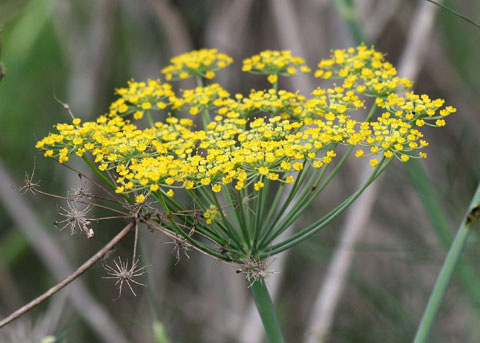Jordan Asberry
Foeniculum vulgare or Sweet Fennel is an invasive plant species commonly found in California. Sweet Fennel are perennial which means that they do not need to be replanted every year, they continue to grow after a period of dormancy. In the late 1800s this plant was introduced to what is now Channel Islands National Park, and was first dispersed by animals. This species is a part of the Apiaceae family, which are angiosperms or plants that have flowers. Some species of Apiaceae can be used in foods for flavor while other species can be harmful to humans if they are consumed. There are also many species of Apiaceae that have a strong scent. The Sweet Fennel is an invasive plant, it forces other native plants to compete with it for resources. It is harder for the other plants to get sunlight, water and nutrients, because this plant tends to take over. Because of these invasive properties, sweet fennel tends to greatly affect and alter the structure of certain wetlands and grasslands. Luckily, Sweet Fennel does not spread at a fast rate when it is not being monitored. Although here are some negative effects of the environment, Sweet Fennel is used for its oil, and as a medicinal plant. Sweet Fennel has been used to treat stomach pains, and other problems the are associated with the abdominal area. One of Fennel Seed oil’s many uses is to treat babies with colic. Infants with colic experience unexpected unhappiness or discomfort that causes them to cry more than normal. The medicinal properties of Sweet Fennel are beneficial to humans, but plant life should also be preserved. Though the Sweet Fennel can be used medicinally, there is potential for many negative effects on the ecosystem. I think that this plant should be monitored and moved to certain areas so that other plant life can be sustained, but the beneficial properties of this plant are not lost.
Sources
- Alexandrovich I, Rakovitskaya O, Kolmo E, Sidorova T, Shushunov S, 8-9-03 (last updated) The effect of fennel (Foeniculum Vulgare) seed oil emulsion in infantile colic: a randomized, placebo-controlled study. https://www.ncbi.nlm.nih.gov/pubmed/12868253 Accessed: 10-16-16
- Badgujar S, Patel V, Bandivdekar A, 8-3-2014 (last updated) Foeniculum vulgare Mill: A Review of Its Botany, Phytochemistry, Pharmacology, Contemporary Application, and Toxicology, https://www.ncbi.nlm.nih.gov/pmc/articles/PMC4137549/ Accessed; 10-16-16
- Callifornia Invasive Plant council, Foeniculum vulgare http://www.cal-ipc.org/ip/management/plant_profiles/Foeniculum_vulgare.php Accesed on: 10-16-16
- Mayo Clinic, 5-15-16 (last updated), Colic http://www.mayoclinic.org/diseases-conditions/colic/basics/definition/con-20019091 Accessed: 10-16-16
- National Park Service, Channel Isalnd national Park, Terrestrial Invasive Plants https://www.nps.gov/chis/learn/nature/terrestrial-invasive.htm Accesed on: 10-16-16
- Natural Resources Conservation Service, Foeniculum vulgare Mill sweet fennel http://plants.usda.gov/core/profile?symbol=fovu Accessed: 10-10-16
- ProFlowers, What is the difference between perennial and annual flowers?http://www.proflowers.com/blog/difference-between-perennial-and-annual-flowers Accessed on: 10-16-16
- The Plant List, Apiaceae http://www.theplantlist.org/browse/A/Apiaceae/ Accessed on: 10-16-16
